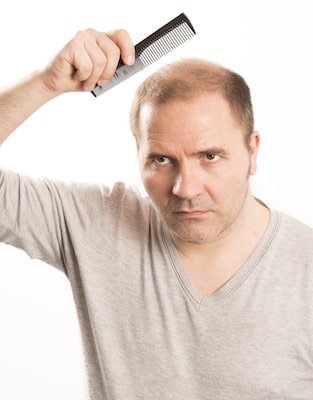Hair Transplant Questions – Answers You Want to Know
The loss of hair can have an impact on the appearance and the self-image of a person. A full and healthy head of hair is often viewed as a symbol of youth and vitality by those that are viewing the hair on the scalp of a person. Thankfully, hair transplants are available to members of the public that want to gain a full and natural looking head of hair. Are you interested in learning more about a hair transplant? If so, take a look at some of the most popular questions we are asked on a daily basis…and learn the answers as well!
Hair Transplant Questions and Answers
What is a hair transplant?
 A hair transplant is when hair is moved from one area of the body of the patient and then transplanted/placed in the balding area of the scalp. The hair is normally moved from the donor area of the scalp (the back and sides of the scalp) and implanted into premade incisions in the balding area of the scalp. The hair from this area of the scalp is normally resistant to balding so surgeons like to use it if there is enough high-quality donor hair located in the donor area of the scalp. Hair can be taken from other areas of the body (such as the beard and chest) if there is not enough donor hair on the scalp.
A hair transplant is when hair is moved from one area of the body of the patient and then transplanted/placed in the balding area of the scalp. The hair is normally moved from the donor area of the scalp (the back and sides of the scalp) and implanted into premade incisions in the balding area of the scalp. The hair from this area of the scalp is normally resistant to balding so surgeons like to use it if there is enough high-quality donor hair located in the donor area of the scalp. Hair can be taken from other areas of the body (such as the beard and chest) if there is not enough donor hair on the scalp.
When was the first modern day hair transplant performed?
Hair restoration, via a modern day hair transplant, was first performed in 1952 by Dr. Norman Orentreich. During these early hair transplants, surgeons used a technique that involved hair plugs. This hair restoration technique involved taking large punch grafts that allowed the doctor to harvest hair from the back of the scalp. These hair grafts were then transplanted to the front of the scalp of the patient.
While this technique was able to transplant hair grafts into the balding areas of the scalp, it did result in an unnatural appearance of multiple circular tufts of hair that was separated by large spaces on the scalp. Current hair transplant techniques do not have any open spaces between the hair follicles so the hairline has a natural look.
Do Hair Transplants Work?
The simple, and most obvious, answer is “Yes” because we would not be in business if they did not provide the desired results that last a lifetime.
The other answer is…Hair transplants work but they are not for everyone. Some people do not have enough donor hair on the scalp, or elsewhere on the body, to transplant to the balding area. There are other patients that simply do not want to undergo any type of medical hair restoration procedure to gain a full head of hair.
The choice to have a hair transplant is up to each individual patient. The decision should be made by consulting with a board-certified surgeon that can set realistic expectations for the patient and also determine the best technique to use to provide the desired results.
What is the Recovery Period for Hair Transplants?
Once the surgery is completed, you will go home and will likely see some swelling in the area of the surgery. You will likely have some pain and/or soreness but these conditions will resolve on their own.
You should not wash your hair until you are given instructions on how to properly wash the area where the hair grafts were placed. After two to four weeks, the hair follicles will enter the resting phase. In two to three months, the transplanted hairs will start to grow in and become longer and thicker.
The final appearance of the hair transplant will be visible within 12-18 months.
Are There Any Side Effects?
Some of the most common side effects of a hair transplant include itching, swelling or pain on the scalp. You can also expect to see some crusting or drainage of pus around the surgical site.
You might also experience some inflammation of the hair follicles which can be caused a fungal or bacterial infection. This is known as folliculitis and often looks like small red bumps or white-head pimples around the hair follicles.
How do I Start the Hair Transplant Process?
The first step is to contact our office and schedule a consultation appointment. Dr. Mohebi or Dr. G will examine your scalp and determine the reason for your hair loss. They will also discuss your medical options and let you ask any questions or voice any concerns you have about the procedure. In addition, the doctor will ask about your hair restoration goals and why you want to undergo a Los Angeles hair transplant or San Francisco hair transplant at one of our medical offices. Beside Los Angeles and San Francisco, you can also schedule a Beverly Hills hair transplant consultation appointment or an online virtual consultation.
Once you and the doctor are in agreement about the results you can achieve by having a hair transplant, your hair restoration surgery can be scheduled.
– MA